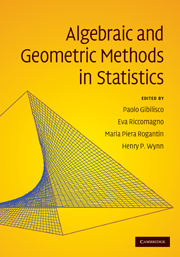Book contents
- Frontmatter
- Contents
- List of contributors
- Preface
- Frequently used notations and symbols
- 1 Algebraic and geometric methods in statistics
- Part I Contingency tables
- Part II Designed experiments
- 9 Generalised design: interpolation and statistical modelling over varieties
- 10 Design of experiments and biochemical network inference
- 11 Replicated measurements and algebraic statistics
- 12 Indicator function and sudoku designs
- 13 Markov basis for design of experiments with three-level factors
- Part III Information geometry
- Part IV Information geometry and algebraic statistics
- Part V On-line supplements
11 - Replicated measurements and algebraic statistics
from Part II - Designed experiments
Published online by Cambridge University Press: 27 May 2010
- Frontmatter
- Contents
- List of contributors
- Preface
- Frequently used notations and symbols
- 1 Algebraic and geometric methods in statistics
- Part I Contingency tables
- Part II Designed experiments
- 9 Generalised design: interpolation and statistical modelling over varieties
- 10 Design of experiments and biochemical network inference
- 11 Replicated measurements and algebraic statistics
- 12 Indicator function and sudoku designs
- 13 Markov basis for design of experiments with three-level factors
- Part III Information geometry
- Part IV Information geometry and algebraic statistics
- Part V On-line supplements
Summary
Abstract
A basic application of algebraic statistics to design and analysis of experiments considers a design as a zero-dimensional variety and identifies it with the ideal of the variety. Then, a subset of a standard basis of the design ideal is used as support for identifiable regression models. Estimation of the model parameters is performed by standard least square techniques. We consider this identifiability problem in the case where more than one measurement is taken at a design point.
Introduction
The application of algebraic geometry to design and analysis of experiments started with (Pistone and Wynn 1996). There a design D, giving settings for experiments, is seen as a finite set of distinct points in ℝk. This is interpreted as the zero set of a system of polynomial equations, which in turn are seen as the generator set of a polynomial ideal (see Chapter 1). The design D is uniquely identified with this ideal called the design ideal and indicated with Ideal (D). Operations over designs find a correspondence in operations over ideals, e.g. union of designs corresponds to intersection of ideals; problems of confounding are formulated in algebraic terms and computer algebra software is an aid in finding their solutions; and a large class of linear regression models identifiable by D is given by vector space bases of a ring, called the quotient ring modulo Ideal (D) and indicated as R/ Ideal(D). This was the beginning of a successful stream of research which, together with the application of algebraic geometry to contingency table analysis covered in the first part of this volume, went under the heading of Algebraic Statistics (Pistone et al. 2001).
- Type
- Chapter
- Information
- Algebraic and Geometric Methods in Statistics , pp. 187 - 202Publisher: Cambridge University PressPrint publication year: 2009



